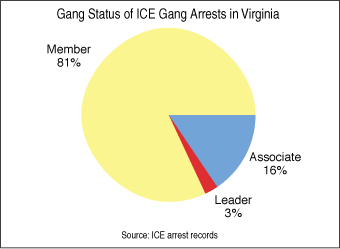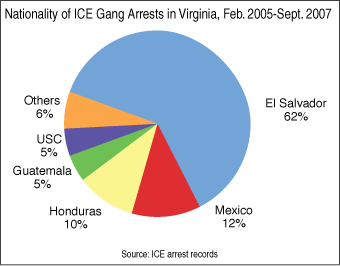Immigration law enforcement has been a key ingredient in the success of criminal gang suppression efforts in Virginia, according to a new report by the Center for Immigration Studies. As state lawmakers consider steps to address the illegal immigration problem this session, they should give high priority to institutionalizing partnerships between state and local law enforcement agencies (LEAs) and federal immigration authorities (ICE), as well as to immigration’s fiscal costs. A large share of those involved with the immigrant gangs active in Virginia, such as MS-13, Surenos, and 18th Street, are illegal aliens. Their illegal status means they are especially vulnerable to law enforcement, and local authorities should take advantage of the immigration tools available in order to disrupt criminal gang activity, remove gang members from the streets, and better protect the public. Once explained, these measures are generally supported in communities around the state, including immigrant communities where much of the immigrant gang violence and crime occurs Among the findings:
- 25-50% of all gangsters arrested in northern and western Virginia are estimated to be deportable aliens. Gang investigators estimate that 90% of the members of MS-13, the most notorious immigrant gang, are illegal aliens.
- More MS-13 members have been nabbed in Virginia than any other ICE jurisdiction in the country (261 arrests out of an estimated population of 2,000 in the state). Nearly 80% of the 341 ICE gang arrests in Virginia were members of MS-13. The remainder belonged to 28 other gangs.
- Immigrant gangsters are responsible for serious and often violent crimes in Virginia. Nine of those arrested by ICE in the last three years were murderers, and six were sex offenders. Their most common crimes were assault and robbery/larceny.
- Gangsters tend to work by day in construction, landscaping, farming, and day labor, and at night are involved in organized crime including drug dealing, prostitution rings, theft, and extortion.
- 62% of alien gangsters arrested in Virginia by ICE were from El Salvador, 12 % were from Mexico, and 10% from Honduras.
- Immigration law provides powerful investigative authorities not available to local or even other federal LEAs. In addition, federal immigration law provides special measures to encourage cooperation of witnesses and informants, and to protect victims of crime.
- Researchers found no “chilling effect” on the reporting of crime as a result of partnerships with ICE. Immigrant community leaders do have an important role to play in reinforcing the message that crime victims and witnesses are not targets of immigration law enforcement.
- Immigrant gangs are multiplying and spreading out across the state, and both ICE and state and local LEAs believe they would benefit greatly from receiving more formal training in immigration law, documentation and related issues that apply to criminal aliens.
Every state and local law enforcement officer interviewed welcomed a partnership with ICE and most praised local ICE agents for responsiveness and assistance. However, some jurisdictions have restricted police ability to make inquiries about immigration status or verify identity of minor lawbreakers, and in some cases refuse to support federal immigration law enforcement. A number of more rural or distant jurisdictions have seen increasing illegal settlement and immigrant gang activity, but have little exposure to immigration issues and little contact with ICE. In addition, ICE’s limited resources, its primary focus on terrorism, and the resulting neglect of routine immigration law enforcement causes frustration in communities facing significant fiscal and economic costs from illegal immigration. ICE’s inability to respond on a consistent basis has fostered complacency and cynicism about immigration law enforcement among some local LEAs.
Gaps in immigration policy and enforcement complicate efforts to disrupt transnational gang activity in Virginia. First, existing border security measures have not prevented the arrival of new illegal alien gangsters from Central America, where perhaps hundreds of thousands of fellow gang members reside. MS-13 gangsters in particular are very mobile and are connected to alien smuggling networks, so deported gang members have been able to return to the area -- one gangster removed from Virginia after serving time made his way back in 7 days. Second, while ICE efforts in Virginia have increased noticeably in recent years with higher numbers of arrests, prosecutions, and removals, resources and staffing remain inadequate to the scale of the illegal alien and criminal alien problem. ICE’s stated policy of tackling “the worst of the worst” leaves a lot of the worst still cycling through the streets and the jails, at considerable cost to state and local government. Finally, few provisions exist in immigration law to bar gang members from obtaining U.S. residency. For example, some gang members have been able to avoid removal because they qualify for temporary protected status (TPS) awarded to Central Americans after natural disasters that took place in 1998 and 2001.
State lawmakers should not expect ICE to deal with the problem of transnational gangs, or criminal aliens in general, on its own. Options are available to increase the number of illegal and criminal aliens who are identified and removed from Virginia. If applied in conjunction with other community-based social and preventative measures, these policies will help disrupt the proliferation of MS-13 and other transnational gangs and prevent future crimes. The relatively modest cost of these measures is more than offset by the benefits to public safety and the likely future cost savings of removing gangsters and other criminals who should not be here in the first place.
Recommendations:
- A state-wide approach to address illegal alien crime is most beneficial and effective, provided it preserves the ability of localities to use their authorities for further efforts as needed.
- Require all LEAs in the state to screen all those in custody for alienage, verify status, and notify ICE as appropriate. All crime databases, especially gang records, should record accurate information on alienage and status.
- Expand the 287(g) and Criminal Alien Programs to address the ICE attention gap and increase criminal removals. Ideally, all gang and drug task forces whose personnel encounter non-citizens should include either an ICE agent or a 287(g)-trained local investigator.
- Increase detention space to accommodate those slated for removal. ICE also offers a “rapid repatriation” program to speed removals and address space crunches.
- All law enforcement officers in Virginia should receive basic introductory training in immigration law (not necessarily 287(g)), to assist in questioning foreign nationals and in recognizing documents, and to avoid procedural mistakes or rights violations.
- Measures to prevent illegal employment will help prevent gangsters from embedding themselves in Virginia communities and discourage illegal settlement in general.



Jessica M. Vaughan, Senior Policy Analyst, is the lead investigator for this project, with research assistance from Jon D. Feere. Graphics are by Tomer Rabizadeh. The project was funded by a grant from the Department of Justice.
